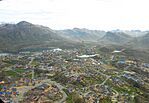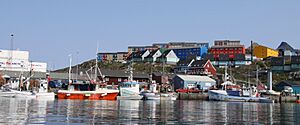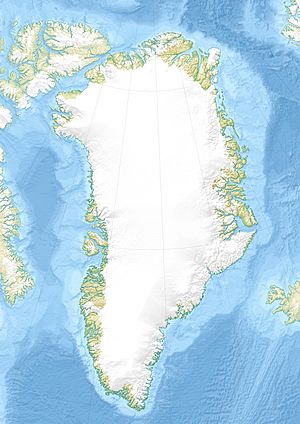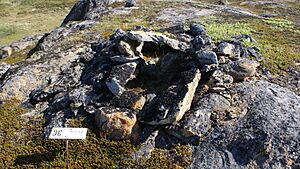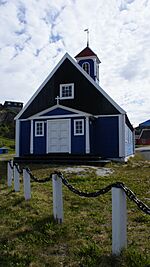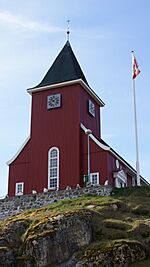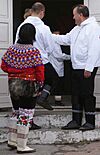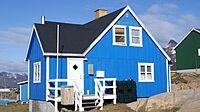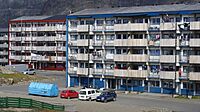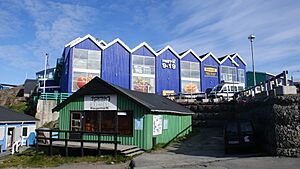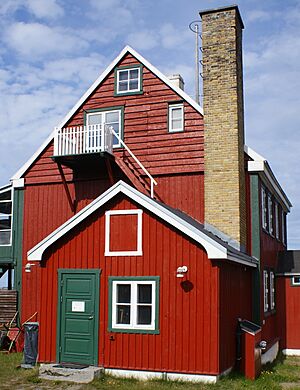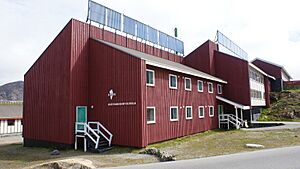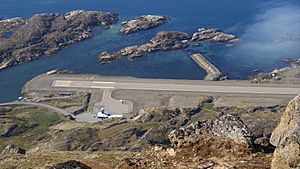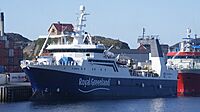Sisimiut facts for kids
Quick facts for kids
Sisimiut
Holsteinsborg
|
|
|---|---|
|
Town centre, Kangerluarsunnguaq Bay, and the massif of Nasaasaaq
|
|
| Country | |
| Part of Denmark | |
| Municipality | Qeqqata |
| First settled | 2500 BCE |
| Founded | 1764 |
| Population
(2020)
|
|
| • Total | 5,582 |
| • Rank | 2nd in Greenland |
| Time zone | UTC−02:00 (West Greenland Time) |
| • Summer (DST) | UTC−02:00 (DST) |
| Postal code |
3911
|
| Website | qeqqata.gl |
Sisimiut (IPA: [sisimiut]), once called Holsteinsborg, is a major city in Greenland. It is the capital and largest city of the Qeqqata area. Sisimiut is the second-largest city in Greenland. It is also the biggest Arctic city in North America. You can find it in central-western Greenland, right on the coast of Davis Strait. It's about 320 kilometers (200 miles) north of Nuuk, Greenland's capital.
The name Sisimiut means "the residents at the foxholes." People have lived here for a very long time, about 4,500 years! First came the Saqqaq culture, then the Dorset culture, and later the Thule people. Today, most people in Sisimiut are descendants of the Thule people, who are Inuit. Many old tools and items from these early settlers have been found. They liked this area because it had lots of animals, especially marine mammals, which they hunted for food.
Modern Sisimiut has a mix of Inuit and Danish people. Danes first settled here in the 1720s. They were led by a Danish missionary named Hans Egede.
Today, Sisimiut is a busy place for business, especially north of Nuuk. It is also one of the fastest-growing cities in Greenland. Fishing is the main job here. The town also has a growing number of other businesses. KNI and its part, Pilersuisoq, have their main offices in Sisimiut. Pilersuisoq is a state-owned chain of stores found all over Greenland. Sisimiut has many types of buildings. You can see traditional family houses and larger apartment blocks built in the 1960s. The city is still growing. New homes are planned for the area north of the port, near the small Kangerluarsunnguaq Bay. Sisimiut also has several schools. These schools teach both local people and those from smaller towns nearby. The new Taseralik Culture Centre is the second cultural center in Greenland. The first one is Katuaq in Nuuk.
The city has its own bus system. Its port is the northernmost one in Greenland that stays open all year because it does not freeze. This port is a shipping base for western and northwestern Greenland. Supply ships leave from here to smaller towns in places like Uummannaq Fjord, Upernavik Archipelago, and even Qaanaaq in northern Greenland. Sisimiut Airport serves the town. Air Greenland flies from here to other towns on Greenland's west coast. You can also fly to Europe by connecting through Kangerlussuaq Airport.
Contents
A Look at Sisimiut's Past
Ancient Times in Sisimiut
The Saqqaq Culture
Sisimiut has been a place where people lived for about 4,500 years. The Saqqaq culture people came from Arctic Canada. They were the first to settle here. They lived in many places along the coast of western Greenland. Back then, the shoreline was much higher than it is today. The Saqqaq people stayed in western Greenland for almost 2,000 years. They left behind many tools and items. Archaeologists have found lots of these things along the coast of Davis Strait. Finds stretch from Disko Bay in the north to the coast near Nuuk in the south.
Scientists have studied a site called Asummiut near the airport. They found that people started living in tiny villages with several families instead of just single homes. Their homes were often tents made from animal hides. They also used stone hearths for fires. There is no sign that they lived in large shared buildings. However, they did hunt reindeer together. They had special gathering spots near their hunting grounds. We know where the Saqqaq people came from thanks to DNA research. But we still don't know why their culture disappeared.
The Dorset Culture
After the Saqqaq people left, no one lived here for a few hundred years. Then, a second group of people came from Canada. These were the Dorset people. The first Dorset people arrived around 500 BCE. They lived in the area for the next 700 years. Later, another group called Dorset II people arrived. But we haven't found many items from them around Sisimiut. We have found some harpoon heads and many animal bones from the early Dorset period. Most Dorset culture items are found further north in the Disko Bay area. The further south you go, the fewer items are found.
The Thule People
The Inuit people of the Thule culture arrived almost 1,000 years ago. Their descendants make up most of the people living in Sisimiut today. The first Thule people came around the 13th and 14th centuries. They had better tools than the Dorset people. They still hunted for food, mostly walruses, reindeer, and especially fur seals. These animals were very important for their way of life.
At that time, the shoreline was still higher than it is now. The Sisimiut valley, east of the Kangerluarsunnguaq Bay, was partly under the sea. Many old items and graves from centuries of settlement are still found in the area. This coastal region, from Sisimiut to Kangaamiut, was very appealing to settlers because it had so many animals. Because of the many historical items found here, this area is being considered for a UNESCO World Heritage Site. The application was sent in 2003.
The Colonial Era
There are no signs that the Norse ever settled in this area. When Hans Egede started the first Danish colonies, Dutch whalers were already here. They quickly burned down his whaling station on Nipisat Island. This island is about 30 kilometers (19 miles) north of Sisimiut today. It wasn't until Jacob Severin was given full control over trade in Greenland that the Dutch were finally removed. This happened after battles in 1738 and 1739.
The town we see today was started in 1764 by the General Trade Company. It was a trading post called Holsteinsborg. It was named after the first chairman of the Danish College of Missions in Copenhagen. This group supported and guided the missionary work in the colony. When it was founded, the local name for the place was Amerlok, named after its fjord. The colonists also started several villages nearby. Only two of them are still here today: Itilleq and Sarfannguit. Under the Royal Greenland Trading Department, Holsteinsborg was a major center for trading reindeer skins.
Several buildings from the 1700s are still standing in Sisimiut. These include the 1725 Gammelhuset ("Old House") and the 1775 Bethel-kirken ("Bethel Church"), also called the "Blue Church." This is the oldest church still standing in Greenland. These buildings were moved from an older settlement site called Ukiivik. A new church was built in 1926 and made bigger in 1984. The entrance to the old church yard has a special gate made from a whale jawbone. In 1801, a smallpox disease greatly reduced the number of people in Sisimiut. But the population quickly grew back because there was so much sea life to hunt.
Sisimiut in Recent Times
The 1900s brought new industries to Sisimiut. A shipping port was built, and a fish processing factory for Royal Greenland opened in 1924. This was the first factory of its kind in Greenland. Fishing is still the main job for people in Sisimiut. The town is now a top center for shrimping and processing shrimp. Until 2008, Sisimiut was the main town for the Sisimiut Municipality. On January 1, 2009, it became part of the new Qeqqata Municipality. Sisimiut kept its role as the main city for this new area. The city council, led by the Mayor, has 13 members. They represent Greenland's main political groups.
Exploring Sisimiut's Geography
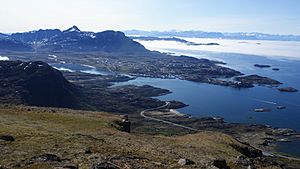
Sisimiut is about 320 kilometers (200 miles) north of Nuuk. It is also about 75 kilometers (47 miles) north of the Arctic Circle. The town sits on rocky hills on the eastern shore of Davis Strait. It is at the western end of a large piece of land. To the north is the Kangerluarsuk Tulleq fjord, and to the south is the wide Amerloq Fjord.
Kangerluarsunnguaq Bay
Right north of Sisimiut is a small bay called Kangerluarsunnguaq Bay. This bay separates the town from the Palasip Qaqqaa mountain in the north. The town's airport is at the foot of this mountain. The mountain has two peaks and is 544 meters (1,785 feet) high. From the top, you can see a wide area, including most of the Qeqqata municipality on clear days.
The bay is easy to sail in. It is protected from the open sea by many small islands called skerries. Both the main port and the local sailing harbor are on the bay's southern shore. The road to the airport crosses the Kangerluarsunnguaq Bay on a bridge. Halfway to the airport, there is a small beach with dark sand. This beach and the small islands off the coast are very popular in the summer.
Alanngorsuaq
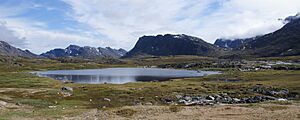
To the east, a wide valley stretches into the land. To the north, it is bordered by the Palasip Qaqqaa and Majoriaq mountains. The Qerrortusup Majoriaa valley runs through it. This is where the Polar Route goes from Sisimiut to Kangerlussuaq. This route is between 150 kilometers (93 miles) and 170 kilometers (106 miles) long.
In the middle of the valley stands the Alanngorsuaq mountain, which is 411 meters (1,348 feet) tall. Several lakes surround it. One of these lakes provides water for Sisimiut. The whole valley is a favorite spot for picnics. It's easy to get to the water reservoirs by a gravel road in the middle of the valley. The reservoirs can hold 882,000 cubic meters (1,153,600 cubic yards) of water. They could provide up to 7,200,000 cubic meters (9,417,000 cubic yards) of water each year.
Nasaasaaq
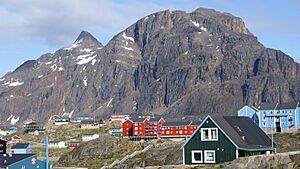
To the southeast, the valley is bordered by the Nasaasaaq mountain range. It has several distinct peaks. The highest peak is 784 meters (2,572 feet) tall. This main peak stands out with a tall, 150-meter (490-foot) cone. The ridge ends with a 611-meter (2,005-foot) peak that looks over Sisimiut. To the east, the ridge slowly drops to about 300 meters (980 feet). Then it turns east-north-east towards the Aappilattorsuaq mountain. The southern side of Nasaasaaq drops straight down to Amerloq Fjord. The northern side is not smooth. It has ledges, cracks, and ramps.
The main path to the top goes through one of the ramps. It leads to the dip between the main peak and its western smaller peak. Ropes are put on the top cone to help tourists who are not experienced climbers. One part of the Polar Route follows the coast of Amerloq Fjord at the base of Nasaasaaq's southern side. People visit the main peak for its wide views of the coast. However, the view to the north is not as good as from Palasip Qaqqaa, which is north of the airport. Another path for climbers goes through a hard-to-find low pass to the east of the main peak. From there, it goes straight up the summit cone ridge.
Sisimiut's Weather
Sisimiut has a polar tundra climate. This means it's cold all year. The average high temperature is 10 degrees Celsius (50 degrees Fahrenheit) or lower throughout the year. February and March are the coldest months. Their average highs are about -10 degrees Celsius (14 degrees Fahrenheit). July and August are the warmest months. Their average highs are about 9 degrees Celsius (48 degrees Fahrenheit). These are the only months when the average low temperatures are above 1 degree Celsius (34 degrees Fahrenheit). Sisimiut does not get much rain. Most rain falls in the second half of the year, from July to December. August and September are the wettest months. Winds from the Davis Strait make the climate milder. The area is known for its fogs. Sisimiut has midnight sun from June 3 to July 9. This means the sun never fully sets during this time. But there is no true polar night in winter.
| Climate data for Sisimiut (1991–2020 normals, extremes 1961–2020) | |||||||||||||
|---|---|---|---|---|---|---|---|---|---|---|---|---|---|
| Month | Jan | Feb | Mar | Apr | May | Jun | Jul | Aug | Sep | Oct | Nov | Dec | Year |
| Record high °C (°F) | 12.5 (54.5) |
12.0 (53.6) |
14.7 (58.5) |
13.3 (55.9) |
20.4 (68.7) |
21.9 (71.4) |
23.5 (74.3) |
23.8 (74.8) |
20.0 (68.0) |
18.4 (65.1) |
16.3 (61.3) |
11.5 (52.7) |
23.8 (74.8) |
| Mean daily maximum °C (°F) | −8.4 (16.9) |
−10.3 (13.5) |
−8.4 (16.9) |
−2.0 (28.4) |
4.0 (39.2) |
9.0 (48.2) |
11.6 (52.9) |
10.7 (51.3) |
6.8 (44.2) |
2.0 (35.6) |
−2.3 (27.9) |
−5.2 (22.6) |
0.6 (33.1) |
| Daily mean °C (°F) | −11.5 (11.3) |
−13.7 (7.3) |
−12.0 (10.4) |
−5.5 (22.1) |
0.7 (33.3) |
5.1 (41.2) |
7.6 (45.7) |
7.3 (45.1) |
4.1 (39.4) |
−0.7 (30.7) |
−5.0 (23.0) |
−8.0 (17.6) |
−2.6 (27.3) |
| Mean daily minimum °C (°F) | −14.5 (5.9) |
−17.0 (1.4) |
−15.5 (4.1) |
−8.9 (16.0) |
−2.2 (28.0) |
1.9 (35.4) |
4.3 (39.7) |
4.5 (40.1) |
1.5 (34.7) |
−3.2 (26.2) |
−7.6 (18.3) |
−10.7 (12.7) |
−5.6 (21.9) |
| Record low °C (°F) | −35.8 (−32.4) |
−38.8 (−37.8) |
−38.2 (−36.8) |
−25.8 (−14.4) |
−19.1 (−2.4) |
−5.6 (21.9) |
−3.0 (26.6) |
−4.5 (23.9) |
−7.9 (17.8) |
−13.0 (8.6) |
−21.0 (−5.8) |
−33.0 (−27.4) |
−38.8 (−37.8) |
| Average precipitation mm (inches) | 48.8 (1.92) |
29.9 (1.18) |
31.5 (1.24) |
32.0 (1.26) |
30.3 (1.19) |
25.1 (0.99) |
51.6 (2.03) |
62.4 (2.46) |
60.5 (2.38) |
62.4 (2.46) |
62.4 (2.46) |
55.7 (2.19) |
552.6 (21.76) |
| Average precipitation days (≥ 0.1 mm) | 10.5 | 10.6 | 11.7 | 10.7 | 9.5 | 9.1 | 10.3 | 10.9 | 12.4 | 13.6 | 14.4 | 13.5 | 137.2 |
| Average snowy days | 10.1 | 10.3 | 11.5 | 10.0 | 7.5 | 2.7 | 0.3 | 0.2 | 4.3 | 11.3 | 13.1 | 13.1 | 94.4 |
| Average relative humidity (%) | 68.5 | 68.5 | 67.3 | 69.1 | 74.8 | 78.2 | 78.5 | 79.2 | 73.3 | 69.7 | 68.6 | 68.6 | 72.0 |
| Mean monthly sunshine hours | 4 | 53 | 144 | 195 | 225 | 237 | 257 | 180 | 137 | 74 | 20 | 0 | 1,550 |
| Source: Danish Meteorological Institute (humidity 1995–2020, sun 1980–1993) | |||||||||||||
People of Sisimiut
Population Growth
In 2020, Sisimiut had 5,582 people living there. It is one of the fastest-growing towns in Greenland. Many people move here from smaller settlements, which helps the town grow. Sisimiut and Kangerlussuaq are the only places in the Qeqqata municipality that have grown steadily over the last 20 years.
There are more men than women in Sisimiut. This has been true for the last two decades. In 2010, almost 10% of the people in town were born outside Greenland. This number has gone down from 16.5% in 1990.
Homes in Sisimiut
Most families in Sisimiut live in single-family houses. These are often colorful wooden homes that come from Denmark already built. They are usually built on concrete foundations because of the permafrost (ground that is always frozen). In the 1960s, Danish officials started building large apartment blocks in many towns in Greenland, including Sisimiut.
New, eco-friendly building methods have not yet reached Sisimiut. In 2010, the older apartment areas were still in need of repairs. However, the Qeqqata municipality is planning to expand the town in the 2010s. The area north of the Kangerluarsunnguaq Bay is set aside for new homes. This new neighborhood will be called Akia.
Jobs and Services in Sisimiut
Main Industries and Businesses
Fishing is the main job in Sisimiut. People catch shrimps, salmon, halibut, and cod. The Royal Greenland fish processing plant at the port is the biggest in Greenland. It is also one of the most modern factories for shelling shrimp in the world. In 2008, this plant processed over 20,000 tons of shrimp! Hunting is also important for some local families. They hunt seals, walrus, beluga whale, narwhal, reindeer, and muskoxen.
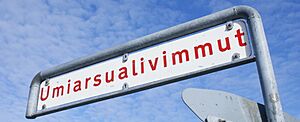
KNI and its part, Pilersuisoq, have their main offices in Sisimiut. Pilersuisoq is a state-owned chain of general stores in Greenland. It runs stores in all small settlements and smaller towns that don't have supermarket chains. Sisimiut has many types of shops. These include chain supermarkets like Pisiffik and Brugsen, as well as smaller independent stores. These shops also supply goods to smaller towns nearby. Polaroil, a company that delivers liquid fuel, has its main office in Sisimiut. It has 70 employees and runs 70 stations in Greenland. Its main office moved from Maniitsoq to Sisimiut in the late 2000s.
There are plans to build an Alcoa aluminium smelting plant here. Maniitsoq, the second-largest town in the area, is also a possible location. This plant would create jobs for 600–700 people. That's more than 10% of the town's population! This is a very important decision for the town. So, the town leaders and the Government of Greenland held many public meetings from 2008 to 2010. They wanted to talk about any concerns about the environment or society. The Sisimiut Hydro Power Plant is north of the town. This plant has two turbines that make 15 megawatts of power. The electricity goes to Sisimiut through a 27.4-kilometer (17.0-mile) long power line.
Even though it doesn't rain much, Sisimiut has plenty of fresh, drinkable water. This water comes from a reservoir under Alanngorsuaq. Water is also pumped to the waterworks from another lake about 2.5 kilometers (1.6 miles) away in the mountains. The water pipes are insulated and heated with electricity. This keeps the water flowing to homes during the winter. The water system can produce about 882,000 cubic meters (1,153,600 cubic yards) of water each year. The two lakes near the town can provide more than 7.2 million cubic meters (9,417,000 cubic yards) of water annually.
Fun Things to Do in Sisimiut
Sisimiut has many places for tourists to stay. These include youth hostels and hotels like Hotel Sisimiut with its Restaurant Nasaasaaq, and Seaman's Home. There is also a conference center. Another notable restaurant is the Misigisaq Restaurant, located at the harbor. It is the only Chinese restaurant in Greenland! It uses local Greenlandic ingredients cooked in a Chinese style. The town has a heated outdoor swimming pool. It is built on stilts so that its heat does not melt the permafrost. Several camping spots are in Sisimiut valley and near the Kangerluarsunnguaq bay. In winter, a ski lift operates at the foot of the Alanngorsuaq mountain. This is at the base of the northern slopes of Nasaasaaq.
Tourism is becoming more and more important here. Several companies offer outdoor adventures. You can go dogsledding, heliskiing, guided hiking, mountaineering, kayaking, and boating all year round. The tough, 160-kilometer (99-mile) long Arctic Circle Race happens every winter. Part of the race path follows the Polar Route from Sisimiut to Kangerlussuaq. This race started in 1998 and is now an international competition.
Learning and Culture in Sisimiut
The Knud Rasmussen High School (Knud Rasmussenip Højskolia) opened in 1962. It is on the eastern edge of town, west of the old heliport. Besides regular subjects, it offers special classes in Greenlandic history and culture. This includes how to prepare animal skins and ski lessons. The school also has a special part called the Women's High School (Greenlandic: Arnat ilinniarfiat), added in 1977. This part focuses on traditional arts. In summer, the school building is used as a hostel. In autumn 2002, the school helped put up stone sculptures around Sisimiut. You can see them near the airport, at the town hall, at a children's home, at the Women's High School, and around the school itself.
Other learning centers in Sisimiut include: Sanaartornermik Ilinniarfik, a school for construction engineering that can teach 200 students; the Arctic Technology Centre; Piareersarfik, a school for people who want to work in the service industry; and Oqaatsinik Pikkorissarfik, a foreign language school.
Sisimiut Museum
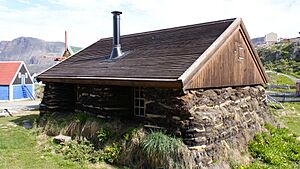
The Sisimiut Museum is in an old building near the harbor. It focuses on Greenlandic trade, industry, and shipping. It has items found during 10 years of digging at ancient Saqqaq culture settlements near the town. These items give us a look into the culture of 4,000 years ago.
The museum also has a collection of tools and household items from 1902–1922. There's also a list of items from the Old Church, including its original altar piece from around 1650, and paintings from the 1790s. You can see a rebuilt peat house from the early 1900s outside. It shows what a Greenlandic home looked like back then. The outdoor exhibit also includes parts of an 18th-century kayak. There's also the Poul Madsen collection, which has handicrafts, art, and other items gathered over 50 years. A collection of Greenlandic stones is shown in the Bygge og Anlægsskolen building.
Arts and Crafts
The modern Taseralik Culture Centre (Greenlandic: Taseralik Kulturikkut) is in the eastern part of Sisimiut. It sits on the shore of the Nalunnguarfik lake. This center often hosts traveling theater groups and concerts, from classical to folk music. Sisimiut Culture Day, on November 21, is also celebrated at Taseralik. Greenlandic handicrafts are made in a workshop at the old harbor. You can buy them at Greenland Travel Incoming's Arts n' Craft and in small shops along the main street. Greenlandic stones and sealskin products are made at the Natseq and Panigiit workshops.
Getting Around Sisimiut
By Air
Sisimiut Airport is about 4.1 kilometers (2.5 miles) northwest of the town. It is at the mouth of the Kangerluarsunnguaq Bay. Before this airport opened in the 1990s, Sisimiut used a heliport. That heliport is now closed and was on the eastern edge of town. The airport has a short runway, only 799 meters (2,621 feet) long. It is only suitable for small planes that can take off and land in short distances. To travel outside of Greenland, you usually change planes at Kangerlussuaq Airport. Air Greenland has regular flights to Nuuk, Maniitsoq, and Ilulissat. Taxis and a town bus connect the airport to the center of Sisimiut.
By Sea
For most of the year, coastal ferries from Arctic Umiaq Line visit Sisimiut twice a week. These ferries connect towns along the western coast. There is also a weekly Royal Arctic Line ferry to Itilleq and Sarfannguit. The port in Sisimiut is the northernmost port in Greenland that stays open all year because it doesn't freeze. It is Greenland's main shipping base north of Nuuk. Supply ships from this port go north. They serve the entire coast, from the Uummannaq Fjord area, through the Upernavik Archipelago, all the way to Qaanaaq in the far north. M/S Akamalik, one of the largest ships in the Royal Greenland fleet, is based in Sisimiut. The port also has Greenland's first shipyard, built in 1931. More than 50 cruise ships visit the port each year. The local kayak club uses the bay harbor, which is east of the main port.
By Land
Roads in Sisimiut, including the road to the airport, are paved. But there are no roads connecting Sisimiut to any other towns, just like in the rest of Greenland. The town has its own bus system. In winter, dog sled routes are used to connect to towns further north. Snowmobiles are also used as a more modern way to travel. Within the town, people often walk. However, private cars and the city bus, which drives loops through town, are also popular.
In the 2000s, there was a lot of talk about building a 170-kilometer (106-mile) road to Kangerlussuaq. This would be the first road of its kind in Greenland, connecting two far-apart towns. It would also reduce the need for people and goods to transfer at Kangerlussuaq Airport. A paved road would have cost about €40 million (about $43 million USD). This was too expensive. So, they decided to build a very simple gravel road for vehicles that can handle rough terrain. This road was built along the route during 2021 and finished in 2022. It cost 25 million DKK (about €3 million or $3.2 million USD).
Partner Towns
Sisimiut is connected with these towns:
 – Albertslund Municipality, Denmark
– Albertslund Municipality, Denmark – Klaksvík, Faroe Islands
– Klaksvík, Faroe Islands
Sisimiut also has friendship links with:
See also
 In Spanish: Sisimiut para niños
In Spanish: Sisimiut para niños







